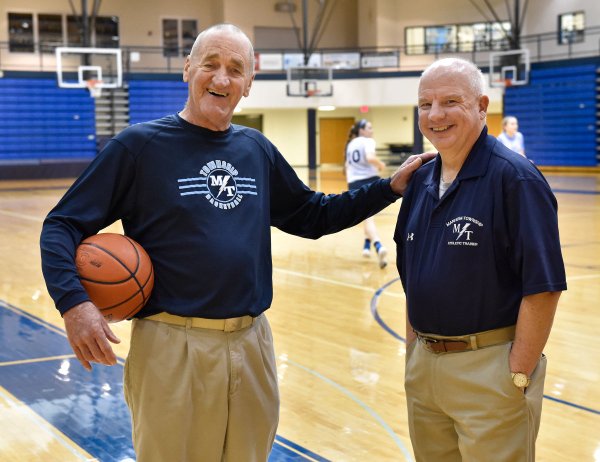
It was a typical Friday practice for assistant coach Mike Hackman and the girls’ varsity basketball team at Manheim Township High School.
But, about 3:20 p.m. on Nov. 20 the 71-year-old collapsed, falling unconscious on the gym floor. Hackman doesn’t have any memory of the tense minutes that followed. He doesn’t recall team members rushing to get medical attention. Nor does he remember the administrators, fellow coaches and medics who came to his aid.
All he’s certain of is that the stars aligned that day for him.
“Let’s face it, I was probably dead,” Hackman said Tuesday.
As Hackman tells it, his “heart went out of a rhythm.” His caretakers at Lancaster General Hospital later told him in detail the seriousness of what he experienced.
“They said if I had been at home, or anywhere where there wasn’t any help, then I’d have been gone,” he said.
Luckily, Dan Quigley, Manheim Township’s longtime athletic trainer, was on the spot.
“I just finished getting football players ready for the game. I was talking to our swim coach, and three or four girls from basketball came running down and said that ‘coach had collapsed,’” Quigley said. “I just ran to where he was.”
Quigley started emergency CPR at once and put an Automated External Defibrillator unit to use.
With nervous administrators and players nearby, Quigley forced breaths into the coach’s lungs, pumped his chest and used the defibrillator to shock the heart.
“It was just instinct,” Quigley said.
A second shock from the defibrillator got Hackman’s heart back in rhythm.
“I think that saved my life, there’s no question about,” Hackman said.
Soon after, the medics arrived and took him to the hospital. Coaches and administrators worked to calm the students.
Roger Czerwinski, Manheim Township athletic director, hurried to the scene after being alerted. He called the actions “heroic.”
“To watch Quigs take control of the situation and establish a sense of direction in a chaotic situation was impressive,” Czerwinski said.
On his road to recovery, Hackman has a larger appreciation for emergency responders, medical professionals and the presence of equipment like the defibrillator.
Of course, he’ll always hold a special spot in his heart for Quigley. The two have seen each other a few times, including at a practice session Hackman was able to attend Wednesday.
“I’ve given him a hug every time I’ve seen him,” Hackman said.
For his part, Quigley tries to downplay his role. “I was just happy to be able to be there for that,” he said.
In his nearly three decades as a trainer, Quigley said he’s used CPR only two other times. Both of those times the people died.
It’s only been in recent years where defibrillators have become more prominent and accessible, Quigley said.
The Manheim Township school has four AED units, which are about the size of a laptop computer, Czerwinski said.
Quigley added he’ll try to make sure area schools update their emergency plans, including making sure they have defibrillators installed.
ORIGINAL ARTICLE:
http://lancasteronline.com/news/local/quick-action-saves-coach-s-life/article_bd9c7464-99ba-11e5-a0fa-c7fc71ba4f6c.html
